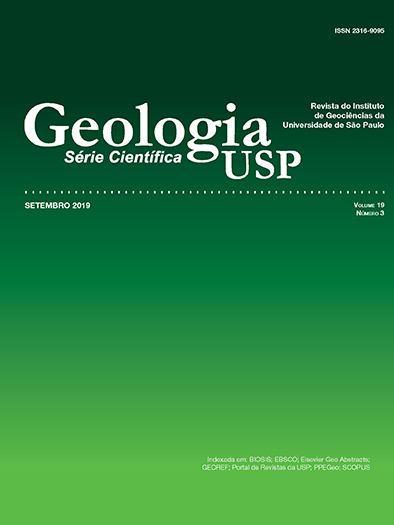Tectono-sedimentary analysis of rift initiation and rift climax stages of the Araripe Basin, Northeast Brazil
DOI:
https://doi.org/10.11606/issn.2316-9095.v19-150526Keywords:
Araripe basin, Sedimentary tectonics, Rift initiation, Rift climax, FaultsAbstract
This paper described the tectonic-sedimentary infilling that occurred during the rift initiation and rift climax stages of Araripe Basin. The main structures identified were, in order of importance, normal, strike-slip and reverse faults. This group of faults laterally places different lithostratigraphic units such as rift initiation and rift climax rocks. An example is the lateral contact of Missão Velho and Brejo Santo formations along normal NNE faults. The integration between geometric and kinematic analysis of these faults with the stratigraphic evolution is of great importance for an overall evolution of the geological evolution of Araripe Basin. Main field outcrops used in this work consist of exhibitions formed during the construction of the Transnordestina railway and the transposition of São Francisco River. Tectonic analysis performed for this work identified two main sets of faults: faults oriented toward NE-SW direction (older ones), and faults oriented toward NW-SE and WNW-ESE direction (younger ones). Additionally, strike-slip and reverse faults were also analyzed. The rift tectonics that affected Araripe Basin (extensional) reactivated old faults of the Pre-Cambrian basement and, in turn, provided normal NE-SW direction fault and also generated E-W and NW-SE orientation faults.
Downloads
Downloads
Published
Issue
Section
License
Authors who publish in this journal shall comply with the following terms:
- Authors keep their copyright and grant to Geologia USP: Série Científica the right of first publication, with the paper under the Creative Commons BY-NC-SA license (summary of the license: https://creativecommons.org/licenses/by-nc-sa/4.0 | full text of the license: https://creativecommons.org/licenses/by-nc-sa/4.0/legalcode) that allows the non-commercial sharing of the paper and granting the proper copyrights of the first publication in this journal.
- Authors are authorized to take additional contracts separately, for non-exclusive distribution of the version of the paper published in this journal (publish in institutional repository or as a book chapter), granting the proper copyrights of first publication in this journal.
- Authors are allowed and encouraged to publish and distribute their paper online (in institutional repositories or their personal page) at any point before or during the editorial process, since this can generate productive changes as well as increase the impact and citation of the published paper (See The effect of Open Access and downloads on citation impact).





